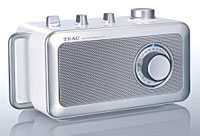 If you find that the modern world is just to fast, too brash, too complicated and just too goddamn digital, you may find TEAC’s new R1 AM/FM Radio the antidote to all those bleeping bits and bytes.
If you find that the modern world is just to fast, too brash, too complicated and just too goddamn digital, you may find TEAC’s new R1 AM/FM Radio the antidote to all those bleeping bits and bytes.
Sporting a classic styling (that worryingly reminds us a bit of Doctor Who’s Cybermen), this is a retro radio that looks like it will be happier blasting out Bill Haley rather than Radiohead.
For starters, there’s not a single LCD, OLED or LED screen in sight, with just a solitary blue light on the large rotary tuning dial serving as a reminder of what century we’re in.
With no station presets on board, users have to find stations the old way, lining up the frequencies etched on the dial against the blue light, while level-tweaking, graphic-preset pushing EQ freaks will have to look elsewhere as the R1 comes with just two stately controls – old fashioned bass and treble.
 Although -disappointingly – there’s no DAB radio to be found onboard, TEAC has included a line-in socket so that users can play back tunes from new fangled iPods or other players.
Although -disappointingly – there’s no DAB radio to be found onboard, TEAC has included a line-in socket so that users can play back tunes from new fangled iPods or other players.
The R-1W measures up at 238 × 134.5 × 127mm, weighs a reassuringly solid 1.4kg and is expected to start appearing in the shops around now.
There’s no UK price announced yet, but we’ve seen it on Americans sites advertised around the $100 (£54) mark.
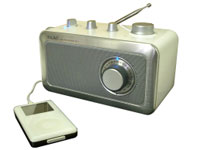 Specifications
Specifications
High-Quality AM/FM Analog Tuner
Gear-Reduction Tuning Dial For Ultra-Fine Tuning
Separate Bass And Treble Controls
Function Selector: AM/FM/AUX/OFF
Large Rotary Volume Control Knob
Telescoping FM Antenna For Outdoor Use
FM “Pigtail-Style” Antenna For Indoor Use
Rear-Panel Headphone Jack
Rear Panel Auxiliary Input (Mini-Jack)
Auxiliary Cable Included For Easy iPod Connection
Auxiliary Input And Cable Compatible With Any Device With A Headphone Output
Integrated Handle For Easy Portability
Built-In Rechargeable Battery
AC Adapter
Dimensions: 9.3″ W x 5.1″ H x 5.2″ D
Weight: 3.3 Pounds
 The second billionth GSM mobile phone is expected to be connected this weekend according to the GSM Association (GSMA).
The second billionth GSM mobile phone is expected to be connected this weekend according to the GSM Association (GSMA).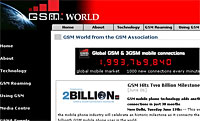 “While it took just 12 years for the industry to reach the first billion connections. The second billion has been achieved in just two and a half years boosted by the phenomenal take up of mobile in emerging markets such as China, India, Africa and Latin America, which accounted for 82% of the second billion subscribers,” he added, breathlessly.
“While it took just 12 years for the industry to reach the first billion connections. The second billion has been achieved in just two and a half years boosted by the phenomenal take up of mobile in emerging markets such as China, India, Africa and Latin America, which accounted for 82% of the second billion subscribers,” he added, breathlessly. The GSM Association continues to develop initiatives to help folks in the developing world gain access to mobile communications, developing a sub$30 low cost mobile phone and putting pressure on governments to remove tax barriers on mobile products and services.
The GSM Association continues to develop initiatives to help folks in the developing world gain access to mobile communications, developing a sub$30 low cost mobile phone and putting pressure on governments to remove tax barriers on mobile products and services.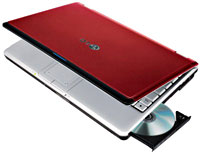 LG has announced their new multimedia-tastic 12-inch notebook PC, the LW25 EXPRESS DUAL, which is, apparently, “a portable multimedia powerhouse.”
LG has announced their new multimedia-tastic 12-inch notebook PC, the LW25 EXPRESS DUAL, which is, apparently, “a portable multimedia powerhouse.” The built in optical drive (or Super Multi ODD as LG likes to call it) supports playback and recording of all existing optical media formats inluding dual-layer DVD burning, allowing you to cram up to 8.5GB data on a single DVD.
The built in optical drive (or Super Multi ODD as LG likes to call it) supports playback and recording of all existing optical media formats inluding dual-layer DVD burning, allowing you to cram up to 8.5GB data on a single DVD. As for pricing and availability, your guess is as good as ours at the moment as LG seem to be keeping mum.
As for pricing and availability, your guess is as good as ours at the moment as LG seem to be keeping mum.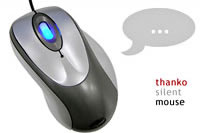 Is your late night keyboard clattering keeping your partner awake? Is your incessant mouse-clicking sending your friends mad? Or have you just got a bit of a problem with clattering, clicking things?
Is your late night keyboard clattering keeping your partner awake? Is your incessant mouse-clicking sending your friends mad? Or have you just got a bit of a problem with clattering, clicking things?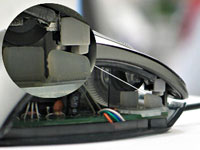 The illustration on their site seems to suggest that they’ve achieved this hush factor by simply slamming in a slab of silicone stuff into the mouse, but we’re sure there must be a bit more hi-tech jiggerypokery involved than that (surely?!!).
The illustration on their site seems to suggest that they’ve achieved this hush factor by simply slamming in a slab of silicone stuff into the mouse, but we’re sure there must be a bit more hi-tech jiggerypokery involved than that (surely?!!). The keyboard that’s as quiet as a, err, mouse
The keyboard that’s as quiet as a, err, mouse It’s a pretty basic looking affair with none of the groovy extras that Logitech like to bolt on, so gadget freaks are unlikely to be impressed.
It’s a pretty basic looking affair with none of the groovy extras that Logitech like to bolt on, so gadget freaks are unlikely to be impressed.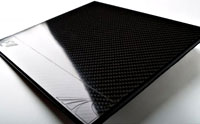 Designed exclusively for idiots with more money than sense, the official Formula 1 carbon and leather mouse mat can now be bought online for just £260 ($489, €380)
Designed exclusively for idiots with more money than sense, the official Formula 1 carbon and leather mouse mat can now be bought online for just £260 ($489, €380)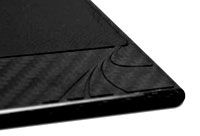 The blurb on the Formula 1 webpage insists that the carbon mouse mat was designed “using state of the art automotive 3D modelling software.”
The blurb on the Formula 1 webpage insists that the carbon mouse mat was designed “using state of the art automotive 3D modelling software.”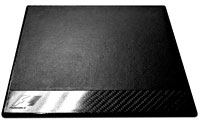 (There is a rather better looking all-carbon version available for ‘just’ £250, but this won’t work with an optical mouse).
(There is a rather better looking all-carbon version available for ‘just’ £250, but this won’t work with an optical mouse).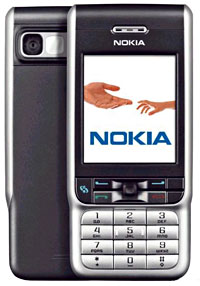 Sad but (supposedly) true: a new study by Nokia has found that over one in five mobile owners said they’d find losing their phone more upsetting than their wallet, credit cards and – unbelievably – even their wedding ring.
Sad but (supposedly) true: a new study by Nokia has found that over one in five mobile owners said they’d find losing their phone more upsetting than their wallet, credit cards and – unbelievably – even their wedding ring.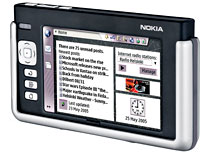 Nokia commissioned the research in 11 countries around the globe to discover people’s attitudes towards current and future mobiles, and generally found that people *heart* the things the planet over.
Nokia commissioned the research in 11 countries around the globe to discover people’s attitudes towards current and future mobiles, and generally found that people *heart* the things the planet over. Surfing on the move
Surfing on the move New research from messaging security specialists Proofpoint has revealed that more than a third of blue-chip companies in both the US and UK hire dedicated staff to snoop on their employee’s emails.
New research from messaging security specialists Proofpoint has revealed that more than a third of blue-chip companies in both the US and UK hire dedicated staff to snoop on their employee’s emails.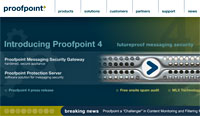 With companies becoming more concerned about internal security breaches rather than external threats, 34 per cent of companies claimed that their business was impacted by the exposure of sensitive or embarrassing information over the last year.
With companies becoming more concerned about internal security breaches rather than external threats, 34 per cent of companies claimed that their business was impacted by the exposure of sensitive or embarrassing information over the last year. In a few years time, kids will be clutching their sides and laughing at the thought that their parents used to watch TV on massive great boxes that filled up half the living room.
In a few years time, kids will be clutching their sides and laughing at the thought that their parents used to watch TV on massive great boxes that filled up half the living room. Style over picture
Style over picture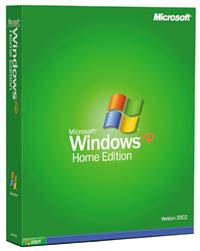 If you’re still running Ye Olde versions of Microsoft Windows XP Service Pack 1 (SP1) and Service Pack 1a (SP1a), you’d better get your modem in gear as Microsoft will be ending support for these products on 10 October, 2006.
If you’re still running Ye Olde versions of Microsoft Windows XP Service Pack 1 (SP1) and Service Pack 1a (SP1a), you’d better get your modem in gear as Microsoft will be ending support for these products on 10 October, 2006.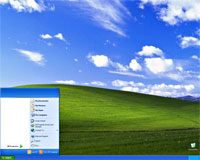 This added USB 2.0 support and a Set Program Access and Defaults utility, letting users control the default application for activities such as web browsing and instant messaging.
This added USB 2.0 support and a Set Program Access and Defaults utility, letting users control the default application for activities such as web browsing and instant messaging. Google is ready to shove its size nines deep into Microsoft territory with the launch of a free Web-based spreadsheet program, Google Spreadsheets.
Google is ready to shove its size nines deep into Microsoft territory with the launch of a free Web-based spreadsheet program, Google Spreadsheets. He explained that the program’s main goal is to make it easier for family, friends or co-workers to read and work on the same spreadsheet from different computers at different times, letting authorised users add and edit data without having to keep sending e-mail attachments back and forth.
He explained that the program’s main goal is to make it easier for family, friends or co-workers to read and work on the same spreadsheet from different computers at different times, letting authorised users add and edit data without having to keep sending e-mail attachments back and forth.